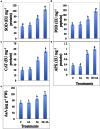Jasmonic Acid Modulates the Physio-Biochemical Attributes, Antioxidant Enzyme Activity, and Gene Expression in Glycine max under Nickel Toxicity
- PMID: 27242811
- PMCID: PMC4864666
- DOI: 10.3389/fpls.2016.00591
Jasmonic Acid Modulates the Physio-Biochemical Attributes, Antioxidant Enzyme Activity, and Gene Expression in Glycine max under Nickel Toxicity
Abstract
In present study, we evaluated the effects of Jasmonic acid (JA) on physio-biochemical attributes, antioxidant enzyme activity, and gene expression in soybean (Glycine max L.) plants subjected to nickel (Ni) stress. Ni stress decreases the shoot and root length and chlorophyll content by 37.23, 38.31, and 39.21%, respectively, over the control. However, application of JA was found to improve the chlorophyll content and length of shoot and root of Ni-fed seedlings. Plants supplemented with JA restores the chlorophyll fluorescence, which was disturbed by Ni stress. The present study demonstrated increase in proline, glycinebetaine, total protein, and total soluble sugar (TSS) by 33.09, 51.26, 22.58, and 49.15%, respectively, under Ni toxicity over the control. Addition of JA to Ni stressed plants further enhanced the above parameters. Ni stress increases hydrogen peroxide (H2O2) by 68.49%, lipid peroxidation (MDA) by 50.57% and NADPH oxidase by 50.92% over the control. Supplementation of JA minimizes the accumulation of H2O2, MDA, and NADPH oxidase, which helps in stabilization of biomolecules. The activities of superoxide dismutase (SOD), peroxidase (POD), catalase (CAT), and ascorbate peroxidase (APX) increases by 40.04, 28.22, 48.53, and 56.79%, respectively, over the control in Ni treated seedlings and further enhancement in the antioxidant activity was observed by the application of JA. Ni treated soybean seedlings showed increase in expression of Fe-SOD by 77.62, CAT by 15.25, POD by 58.33, and APX by 80.58% over the control. Nevertheless, application of JA further enhanced the expression of the above genes in the present study. Our results signified that Ni stress caused negative impacts on soybean seedlings, but, co-application of JA facilitate the seedlings to combat the detrimental effects of Ni through enhanced osmolytes, activity of antioxidant enzymes and gene expression.
Keywords: antioxidants; growth; jasmonic acid; lipid peroxidation; nickel stress; osmolytes; reactive oxygen species; soybean.
Figures




Similar articles
-
Modulatory role of jasmonic acid on photosynthetic pigments, antioxidants and stress markers of Glycine max L. under nickel stress.Physiol Mol Biol Plants. 2015 Oct;21(4):559-65. doi: 10.1007/s12298-015-0320-4. Epub 2015 Oct 1. Physiol Mol Biol Plants. 2015. PMID: 26600682 Free PMC article.
-
Salicylic acid and jasmonic acid restrains nickel toxicity by ameliorating antioxidant defense system in shoots of metallicolous and non-metallicolous Alyssum inflatum Náyr. Populations.Plant Physiol Biochem. 2019 Feb;135:450-459. doi: 10.1016/j.plaphy.2018.11.015. Epub 2018 Nov 14. Plant Physiol Biochem. 2019. PMID: 30497973
-
Seed priming and foliar application with jasmonic acid enhance salinity stress tolerance of soybean (Glycine max L.) seedlings.J Sci Food Agric. 2021 Mar 30;101(5):2027-2041. doi: 10.1002/jsfa.10822. Epub 2020 Oct 6. J Sci Food Agric. 2021. PMID: 32949013
-
Exogenous jasmonic acid can enhance tolerance of wheat seedlings to salt stress.Ecotoxicol Environ Saf. 2014 Jun;104:202-8. doi: 10.1016/j.ecoenv.2014.03.014. Epub 2014 Apr 13. Ecotoxicol Environ Saf. 2014. PMID: 24726929
-
Effects of jasmonic acid in foliar spray and an humic acid amendment to saline soils on forage sorghum plants' growth and antioxidant defense system.PeerJ. 2022 Oct 14;10:e13793. doi: 10.7717/peerj.13793. eCollection 2022. PeerJ. 2022. PMID: 36262417 Free PMC article.
Cited by
-
Plant hormones and neurotransmitter interactions mediate antioxidant defenses under induced oxidative stress in plants.Front Plant Sci. 2022 Sep 9;13:961872. doi: 10.3389/fpls.2022.961872. eCollection 2022. Front Plant Sci. 2022. PMID: 36176673 Free PMC article. Review.
-
Silicon-induced antioxidant defense and methylglyoxal detoxification works coordinately in alleviating nickel toxicity in Oryza sativa L.Ecotoxicology. 2019 Apr;28(3):261-276. doi: 10.1007/s10646-019-02019-z. Epub 2019 Feb 13. Ecotoxicology. 2019. PMID: 30761430
-
Impact of Post-Translational Modifications of Crop Proteins under Abiotic Stress.Proteomes. 2016 Dec 21;4(4):42. doi: 10.3390/proteomes4040042. Proteomes. 2016. PMID: 28248251 Free PMC article. Review.
-
Jasmonic acid (JA) and gibberellic acid (GA3) mitigated Cd-toxicity in chickpea plants through restricted cd uptake and oxidative stress management.Sci Rep. 2021 Oct 5;11(1):19768. doi: 10.1038/s41598-021-98753-8. Sci Rep. 2021. PMID: 34611203 Free PMC article.
-
Endophytic Paecilomyces formosus LHL10 Augments Glycine max L. Adaptation to Ni-Contamination through Affecting Endogenous Phytohormones and Oxidative Stress.Front Plant Sci. 2017 May 29;8:870. doi: 10.3389/fpls.2017.00870. eCollection 2017. Front Plant Sci. 2017. PMID: 28611799 Free PMC article.
References
-
- Abdel Latef A. A. M., Jan S., Abd Allah E. F., Rashid B., John R., Ahmad P. (2016). “Soybean under abiotic stress: proteomic approach,” in Plant-Environment Interaction: Responses and Approaches to Mitigate Stress, eds Azooz M. M., Ahmad P. (Chichester: John Wiley; ), 28–42.
-
- Abu-Romman S., Shatnawi M. (2011). Isolation and expression analysis of chloroplastic copper/zinc superoxide dismutase gene in barley. S. Afr. J. Bot. 77 328–334. 10.1016/j.sajb.2010.09.012 - DOI
-
- Ahmad P. (2013). Oxidative Damage to Plants, Antioxidant Networks and Signaling. Cambridge, MA: Academic Press.
LinkOut - more resources
Full Text Sources
Other Literature Sources
Miscellaneous

